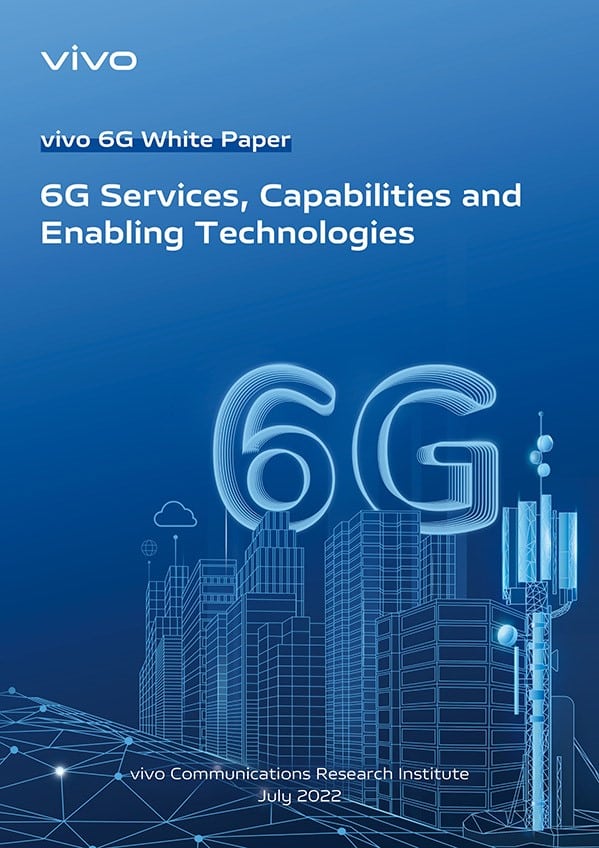vivo Communications Research Institute has released its third 6G white paper, “Building a Freely Connected Physical and Digital Integrated World: 6G Services, Capabilities and Enabling Technologies”.
The report explores the 6G framework and enabling technologies that vivo experts believe will shape people’s lives beyond 2030.
“As one of the world’s leading smartphone vendors, we are dedicated to empowering consumers by making cutting-edge 5G smartphones affordable and accessible. At the same time, we have set our sights on the future i.e. 6G,” said Qin Fei, President of vivo Communications Research Institute.
“At the forefront of R&D, we continue to explore what a 6G world might look like and what technologies we need to develop to get there,” he added.
Over the past two years, the industry has been gradually forming a consensus on the services that may be provided by 6G and the key capability indicators that need to be achieved.
The research and development of related key enabling technologies are also gaining momentum. The vivo Communications Research Institute has been actively contributing to shaping the future of 6G with in-depth analysis and evaluation of 6G business models and drivers, application scenarios, system architecture, and enabling technologies.
vivo’s latest white paper on 6G builds on two earlier works released in 2020, including ‘Digital Life 2030+’, which provides insights into some of the many potential 6G digital scenarios for the next decade, and ‘6G Vision, Requirements and Challenges’, which outlines vivo’s vision for 6G, namely that 6G will enable the convergence of the digital and physical worlds.
Services and Capabilities
The white paper proposes that 6G will provide super communication, information, and converged computing services, becoming a base for an interconnected and converged physical and digital world.
According to the analysis, 6G will converge communication, computation, and sensing in a single system. An integrated 6G network will not only connect humans to humans, but it will also connect humans to machines and machines to machines, helping create a whole new digital world.
It can be expected that hundreds of billions of devices will be connected by 2030.
“6G will allow us to bring the next generation of connectivity into every aspect of people’s lives. It will integrate more access technologies, cover a larger physical space, and provide better core capabilities, supporting more services,” said Rakesh Tamrakar, 5G Standard Expert at vivo.
“By seamlessly connecting industries, transportation, workspace, and homes, 6G will contribute greatly to society – from the democratization of professional talent to the enhancement of emergency and disaster response,” he added.
6G will expand basic telecom services to support completely new experiences, such as immersive mixed reality and holographic and multi-sensory communication.
6G mobile data connectivity services will continue to improve in capacity, data rate, latency, reliability, and many other aspects. This will broaden the range of customers and increase the value of services, with more end-to-end flexibility and adaptability to meet the needs of individuals and industries.
This means that every performance indicator, such as data rate, including peak data rate and user experienced data rate, communication delay, and area traffic capacity, will need to be improved several folds or more compared with 5G.
6G service capability definition requires careful consideration of demand, technology, and cost, balancing performance metrics and efficiency indicators.
Enabling Technologies
New network functions need to be introduced to support the new 6G services and achieve integration of sensing and communication.
6G will converge mobile network and computing, cross-domain data interaction, and native AI network. Therefore, it requires a brand-new system architecture design.
Integrating sensing and communication taps into a new area of opportunity in cellular wireless networks – 6G native AI would improve network and air interface efficiency, enhance system flexibility and reduce cost.
The introduction of an end-to-end cross-layer data plane is essential to support intelligent and basic information services. Extremely low-power communication reduces the barrier to terminal access, enabling truly ubiquitous connectivity.
Currently, the Multiple-Input Multiple-Output (MIMO) evolution, Reconfigurable Intelligent Surface (RIS) technology, and new waveforms are some of the exciting research areas, paving the way towards a more efficient and more flexible network that can support more application scenarios, and offer more advanced sensing functions.
The research and development of 6G technology standards are still in the early stage.
The vivo Communications Research Institute is dedicated to continuing to refine 6G scenario use cases and technical indicators, carrying out in-depth research and experimental verification of potential 6G technologies, and contributing to the development of a globally unified 6G technology standard.
The “Building a Freely Connected Physical and Digital Integrated World: 6G Services, Capabilities and Enabling Technologies ” white paper is available for download here.


























